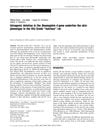TLDR Monilethrix involves multiple genes affecting hair structure, including DSG4 mutations.
Research on monilethrix, a hereditary hair disorder, revealed that while it was initially linked to mutations in type II hair cortex keratins, other genetic factors were also involved. Specifically, mutations in the desmoglein 4 (DSG4) gene, a desmosomal cadherin, were identified as significant contributors to monilethrix and localized autosomal recessive hypotrichosis (LAH). These mutations disrupted cell-cell adhesion in hair follicles, leading to hair abnormalities in both humans and animal models. The study highlighted specific mutations, such as Pro267Arg, and suggested that the beaded hair phenotype in monilethrix might result from oscillations in hair follicle differentiation processes. This research provided new insights into the genetic basis of these hair disorders, although the autosomal dominant form of monilethrix was not explored.
97 citations
,
March 2006 in “Journal of Investigative Dermatology”  74 citations
,
January 2006 in “The journal of investigative dermatology/Journal of investigative dermatology”
74 citations
,
January 2006 in “The journal of investigative dermatology/Journal of investigative dermatology” Mutations in the DSG4 gene can cause a rare hair disorder similar to monilethrix.
33 citations
,
October 2005 in “Journal of Investigative Dermatology” 79 citations
,
March 2005 in “Journal of Medical Genetics” 276 citations
,
January 2005 in “International review of cytology”  28 citations
,
October 2004 in “Differentiation”
28 citations
,
October 2004 in “Differentiation” A gene deletion causes the "hairless" trait in Iffa Credo rats.
44 citations
,
August 2004 in “Journal of Investigative Dermatology” 50 citations
,
February 2004 in “Genomics” A gene mutation causes lanceolate hair in rats by disrupting hair shaft integrity.
37 citations
,
June 2000 in “Experimental dermatology” The Lanceolate hair-J mutation in mice mimics human hair disorders like Netherton's syndrome.
30 citations
,
December 1996 in “Journal of Investigative Dermatology” 36 citations
,
July 1996 in “The journal of investigative dermatology/Journal of investigative dermatology” Mice with the 'lanceolate hair' mutation have abnormal hair and skin similar to human Netherton's syndrome.
 19 citations
,
May 2004 in “The American Journal of Dermatopathology”
19 citations
,
May 2004 in “The American Journal of Dermatopathology” The research found that a specific gene mutation causes fewer hair follicles and disrupted hair growth cycles, leading to thin and short hair in people with Hypotrichosis with Juvenile Macular Dystrophy.


